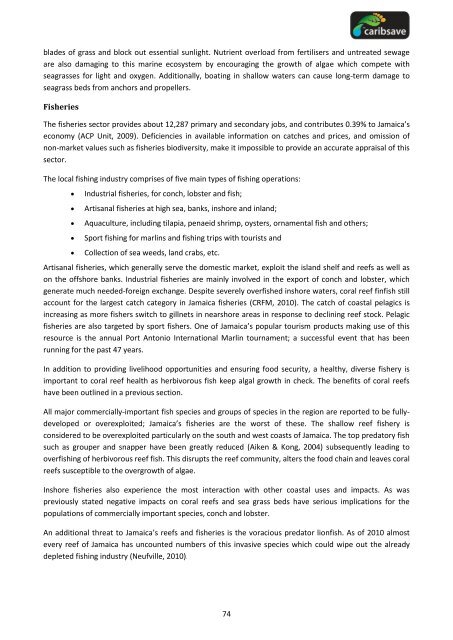THE CARIBSAVE CLIMATE CHANGE RISK ATLAS
THE CARIBSAVE CLIMATE CHANGE RISK ATLAS
THE CARIBSAVE CLIMATE CHANGE RISK ATLAS
Create successful ePaper yourself
Turn your PDF publications into a flip-book with our unique Google optimized e-Paper software.
lades of grass and block out essential sunlight. Nutrient overload from fertilisers and untreated sewage<br />
are also damaging to this marine ecosystem by encouraging the growth of algae which compete with<br />
seagrasses for light and oxygen. Additionally, boating in shallow waters can cause long-term damage to<br />
seagrass beds from anchors and propellers.<br />
Fisheries<br />
The fisheries sector provides about 12,287 primary and secondary jobs, and contributes 0.39% to Jamaica’s<br />
economy (ACP Unit, 2009). Deficiencies in available information on catches and prices, and omission of<br />
non-market values such as fisheries biodiversity, make it impossible to provide an accurate appraisal of this<br />
sector.<br />
The local fishing industry comprises of five main types of fishing operations:<br />
� Industrial fisheries, for conch, lobster and fish;<br />
� Artisanal fisheries at high sea, banks, inshore and inland;<br />
� Aquaculture, including tilapia, penaeid shrimp, oysters, ornamental fish and others;<br />
� Sport fishing for marlins and fishing trips with tourists and<br />
� Collection of sea weeds, land crabs, etc.<br />
Artisanal fisheries, which generally serve the domestic market, exploit the island shelf and reefs as well as<br />
on the offshore banks. Industrial fisheries are mainly involved in the export of conch and lobster, which<br />
generate much needed-foreign exchange. Despite severely overfished inshore waters, coral reef finfish still<br />
account for the largest catch category in Jamaica fisheries (CRFM, 2010). The catch of coastal pelagics is<br />
increasing as more fishers switch to gillnets in nearshore areas in response to declining reef stock. Pelagic<br />
fisheries are also targeted by sport fishers. One of Jamaica’s popular tourism products making use of this<br />
resource is the annual Port Antonio International Marlin tournament; a successful event that has been<br />
running for the past 47 years.<br />
In addition to providing livelihood opportunities and ensuring food security, a healthy, diverse fishery is<br />
important to coral reef health as herbivorous fish keep algal growth in check. The benefits of coral reefs<br />
have been outlined in a previous section.<br />
All major commercially-important fish species and groups of species in the region are reported to be fullydeveloped<br />
or overexploited; Jamaica’s fisheries are the worst of these. The shallow reef fishery is<br />
considered to be overexploited particularly on the south and west coasts of Jamaica. The top predatory fish<br />
such as grouper and snapper have been greatly reduced (Aiken & Kong, 2004) subsequently leading to<br />
overfishing of herbivorous reef fish. This disrupts the reef community, alters the food chain and leaves coral<br />
reefs susceptible to the overgrowth of algae.<br />
Inshore fisheries also experience the most interaction with other coastal uses and impacts. As was<br />
previously stated negative impacts on coral reefs and sea grass beds have serious implications for the<br />
populations of commercially important species, conch and lobster.<br />
An additional threat to Jamaica’s reefs and fisheries is the voracious predator lionfish. As of 2010 almost<br />
every reef of Jamaica has uncounted numbers of this invasive species which could wipe out the already<br />
depleted fishing industry (Neufville, 2010).<br />
74





